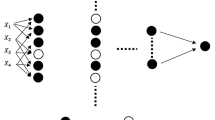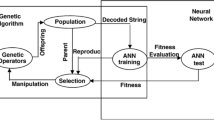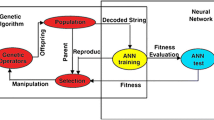Abstract
Shear strength parameters such as cohesion are the most significant rock parameters which can be utilized for initial design of some geotechnical engineering applications. In this study, evaluation and prediction of rock material cohesion is presented using different approaches i.e., simple and multiple regression, artificial neural network (ANN) and genetic algorithm (GA)-ANN. For this purpose, a database including three model inputs i.e., p-wave velocity, uniaxial compressive strength and Brazilian tensile strength and one output which is cohesion of limestone samples was prepared. A meaningful relationship was found for all of the model inputs with suitable performance capacity for prediction of rock cohesion. Additionally, a high level of accuracy (coefficient of determination, R 2 of 0.925) was observed developing multiple regression equation. To obtain higher performance capacity, a series of ANN and GA-ANN models were built. As a result, hybrid GA-ANN network provides higher performance for prediction of rock cohesion compared to ANN technique. GA-ANN model results (R 2 = 0.976 and 0.967 for train and test) were better compared to ANN model results (R 2 = 0.949 and 0.948 for train and test). Therefore, this technique is introduced as a new one in estimating cohesion of limestone samples.








Similar content being viewed by others
References
Jahed Armaghani D, Hajihassani M, Yazdani Bejarbaneh B et al (2014) Indirect measure of shale shear strength parameters by means of rock index tests through an optimized artificial neural network. Meas J Int Meas Confed 55:487–498. https://doi.org/10.1016/j.measurement.2014.06.001
Alejano L, Carranza-Torres C (2011) An empirical approach for estimating shear strength of decomposed granites in Galicia, Spain. Eng Geol 120:91–102
Mohamad ET, Armaghani DJ, Momeni E et al (2016) Rock strength estimation: a PSO-based BP approach. Neural Comput Appl 1–12. https://doi.org/10.1007/s00521-016-2728-3
Jahed Armaghani D, Mohd Amin MF, Yagiz S et al (2016) Prediction of the uniaxial compressive strength of sandstone using various modeling techniques. Int J Rock Mech Min Sci 85:174–186. https://doi.org/10.1016/j.ijrmms.2016.03.018
Zorlu K, Gokceoglu C, Ocakoglu F et al (2008) Prediction of uniaxial compressive strength of sandstones using petrography-based models. Eng Geol 96:141–158
Jahed Armaghani D, Safari V, Fahimifar A et al (2017) Uniaxial compressive strength prediction through a new technique based on gene expression programming. Neural Comput Appl. https://doi.org/10.1007/s00521-017-2939-2
Monjezi M, Khoshalan H, Razifard M (2012) A neuro-genetic network for predicting uniaxial compressive strength of rocks. Geotech Geol Eng 30:1053–1062
Bejarbaneh BY, Bejarbaneh EY, Amin MFM et al (2016) Intelligent modelling of sandstone deformation behaviour using fuzzy logic and neural network systems. Bull Eng Geol Environ. https://doi.org/10.1007/s10064-016-0983-2
Liu H, Kou S, Lindqvist P, Tang C (2004) Numerical studies on the failure process and associated microseismicity in rock under triaxial compression. Tectonophysics 384:149–174
Kahraman S, Altun H, Tezekici B (2006) Sawability prediction of carbonate rocks from shear strength parameters using artificial neural networks. Int J Rock Mech Min Sci 43:157–164
Sarout J, Molez L, Guéguen Y, Hoteit N (2007) Shale dynamic properties and anisotropy under triaxial loading: experimental and theoretical investigations, vol 32. Phys Chem Earth, Parts A/B/C, pp 896–906
Barla G, Barla M, Debernardi D (2010) New triaxial apparatus for rocks. Rock Mech rock Eng 43:225–230
Amann F, Kaiser P, Button E (2012) Experimental study of brittle behavior of clay shale in rapid triaxial compression. Rock Mech rock Eng 45:21–33
Asadi M, Bagheripour M (2014) Numerical and intelligent modeling of triaxial strength of anisotropic jointed rock specimens. Earth Sci Informatics 7:165–172
Chong K, Chen J, Dana G, Sailor S (1984) Triaxial testing of devonian oil shale. J Geotech Eng 110:1491–1497
Iannacchione A, Vallejo L (2000) Shear strength evaluation of Clay-Rock mixtures. Slope Stab 2000:209–223
Singh M, Singh B (2012) Modified Mohr–Coulomb criterion for non-linear triaxial and polyaxial strength of jointed rocks. Int J Rock Mech Min 51:43–52
Barton N (1976) The shear strength of rock and rock joints. Int J rock Mech Min Sci Geomech Abstr 13:255–279
Hajdarwish A, Shakoor A (2006) Predicting the shear strength parameters of mudrocks. Geol Soc London 607
Hoek E, Carranza-Torres C (2002) Hoek–Brown failure criterion-2002 edition. Proc NARMS-Tac 1:267–273
Yazdani B (2012) Shear strength parameters of Shale based on triaxial compression test. Universiti Teknologi Malaysia, Malaysia
Ghazvinian A, Vaneghi R, Hadei M (2013) Shear behavior of inherently anisotropic rocks. Int J Rock Mech Min Sci 61:96–110
Islam M, Skalle P (2013) An experimental investigation of shale mechanical properties through drained and undrained test mechanisms. Rock Mech Rock Eng 46:1391–1413
Barton N (2013) Shear strength criteria for rock, rock joints, rockfill and rock masses: Problems and some solutions. J Rock Mech Geotech Eng 249–261
Armaghani DJ, Momeni E, Abad SVANK, Khandelwal M (2015) Feasibility of ANFIS model for prediction of ground vibrations resulting from quarry blasting. Environ Earth Sci 74(4):2845–2860
Khandelwal M, Kankar PK, Harsha SP (2010) Evaluation and prediction of blast induced ground vibration using support vector machine. Min Sci Technol 20(1):64–70
Monjezi M, Ahmadi Z, Varjani AY, Khandelwal M (2013) Backbreak prediction in the Chadormalu iron mine using artificial neural network. Neural Comput Applic 23(3–4):1101–1107
Khandelwal M (2011) Blast-induced ground vibration prediction using support vector machine. Eng Comput 27(3):193–200
Khandelwal M, Singh TN (2011) Predicting elastic properties of schistose rocks from unconfined strength using intelligent approach. Arab J Geosci 4(3–4):435–442
Khandelwal M, Armaghani DJ (2016) Prediction of drillability of rocks with strength properties using a hybrid GA-ANN technique. Geotech Geol Eng 34:605–620. https://doi.org/10.1007/s10706-015-9970-9
Armaghani DJ, Mohamad ET, Narayanasamy MS et al (2017) Development of hybrid intelligent models for predicting TBM penetration rate in hard rock condition. Tunn Undergr Sp Technol 63:29–43. https://doi.org/10.1016/j.tust.2016.12.009
Khandelwal M, Singh TN (2009) Prediction of blast-induced ground vibration using artificial neural network. Int J Rock Mech Min Sci 46:1214–1222. https://doi.org/10.1016/j.ijrmms.2009.03.004
Eberhart R, Simpson P, Dobbins R (1996) Computational intelligence PC tools. Acad. Press Prof. Inc
Eberhart R, Shi Y (1998) Evolving artificial neural networks. Proc Int Conf Neural Netw Brain 1:PL5–PL13
Adhikari R, Agrawal R (2011) Effectiveness of PSO based neural network for seasonal time series forecasting. IICAI 3:231–244
Monjezi M, Khoshalan HA, Varjani AY (2012) Prediction of flyrock and backbreak in open pit blasting operation: a neuro-genetic approach. Arab J Geosci 5:441–448
Tonnizam Mohamad E, Jahed Armaghani D, Hasanipanah M et al (2016) Estimation of air-overpressure produced by blasting operation through a neuro-genetic technique. Environ Earth Sci. https://doi.org/10.1007/s12665-015-4983-5
Aghajanloo M, Sabziparvar A, Talaee P (2013) Artificial neural network–genetic algorithm for estimation of crop evapotranspiration in a semi-arid region of Iran. Neural Comput 23:1387–1393
Garrett J (1994) Where and why artificial neural networks are applicable in civil engineering, pp 129–130
Armaghani D, Momeni E, Abad S (2015) Feasibility of ANFIS model for prediction of ground vibrations resulting from quarry blasting. Environ Earth Sci 74:2845–2860
Simpson P (1990) Artificial neural systems. Pergamon, 1990
Dreyfus G (2005) Neural networks: methodology and applications. Springer, Berlin
Hajihassani M, Armaghani D, Marto A (2015) Ground vibration prediction in quarry blasting through an artificial neural network optimized by imperialist competitive algorithm. Bull Eng Geol Environ 74:873–886
Armaghani D, Mohamad E, Hajihassani M (2016) Evaluation and prediction of flyrock resulting from blasting operations using empirical and computational methods. Eng Comput 32:109–121
Saemi M, Ahmadi M, Varjani A (2007) Design of neural networks using genetic algorithm for the permeability estimation of the reservoir. J Pet Sci Eng 59:97–105
Holland JH (1992) Adaptation in natural and artificial systems: an introductory analysis with applications to biology, control, and artificial intelligence. MIT press
Momeni E, Nazir R, Armaghani D, Maizir H (2014) Prediction of pile bearing capacity using a hybrid genetic algorithm-based ANN. Measurement 57:122–131
Brown ET (1981) Rock characterization, testing and monitoring: ISRM suggested methods. Suggest. methods Prep. by Comm. Test. methods. Int. Soc. RockMechanics Turkish Natl. Group, Ankara
Hatheway AW (2009) The complete ISRM suggested methods for rock characterization, testing and monitoring; 1974–2006
Bieniawski ZT, Bernede MJ (1979) Suggested methods for determining the uniaxial compressive strength and deformability of rock materials: Part 1. Suggested method for determining deformability of rock materials in uniaxial compression. Int. J. Rock Mech. Min. Sci. Geomech. Abstr. Elsevier, pp 138–140
Jaeger JC (1967) Failure of rocks under tensile conditions. Int. J. Rock Mech. Min. Sci. Geomech. Abstr. Elsevier, pp 219–227
Jahed Armaghani D, Hajihassani M, Monjezi M et al (2015) Application of two intelligent systems in predicting environmental impacts of quarry blasting. Arab J Geosci 8:9647–9665. https://doi.org/10.1007/s12517-015-1908-2
Released SI (2007) SPSS for Windows, Version 16.0. SPSS Inc., Chicago
Hecht-Nielsen R (1987) Kolmogorov’s mapping neural network existence theorem. In: Proc. Int. Conf. Neural Networks. IEEE Press, New York, pp 11–13
Ripley BD (1993) Statistical aspects of neural networks. Networks chaos—statistical probabilistic Asp 50:40–123
Paola JD (1994) Neural network classification of multispectral imagery. Master Tezi, Univ. Arizona, USA
Wang C (1994) A theory of generalization in learning machines with neural network applications
Masters T (1993) Practical neural network recipes in C++. Morgan Kaufmann
Kaastra I, Boyd M (1996) Designing a neural network for forecasting financial and economic time series. Neurocomputing 10:215–236
Kanellopoulos I, Wilkinson GG (1997) Strategies and best practice for neural network image classification. Int J Remote Sens 18:711–725
Lee Y, Oh S-H, Kim MW (1991) The effect of initial weights on premature saturation in back-propagation learning. Neural Networks, 1991., IJCNN-91-Seattle Int. Jt. Conf. IEEE, pp 765–770
Chambers LD (1998) Practical handbook of genetic algorithms: complex coding systems. CRC press
Swingler K (1996) Applying neural networks: a practical guide. Academic Press, New York
Author information
Authors and Affiliations
Corresponding author
Rights and permissions
About this article
Cite this article
Khandelwal, M., Marto, A., Fatemi, S.A. et al. Implementing an ANN model optimized by genetic algorithm for estimating cohesion of limestone samples. Engineering with Computers 34, 307–317 (2018). https://doi.org/10.1007/s00366-017-0541-y
Received:
Accepted:
Published:
Issue Date:
DOI: https://doi.org/10.1007/s00366-017-0541-y




